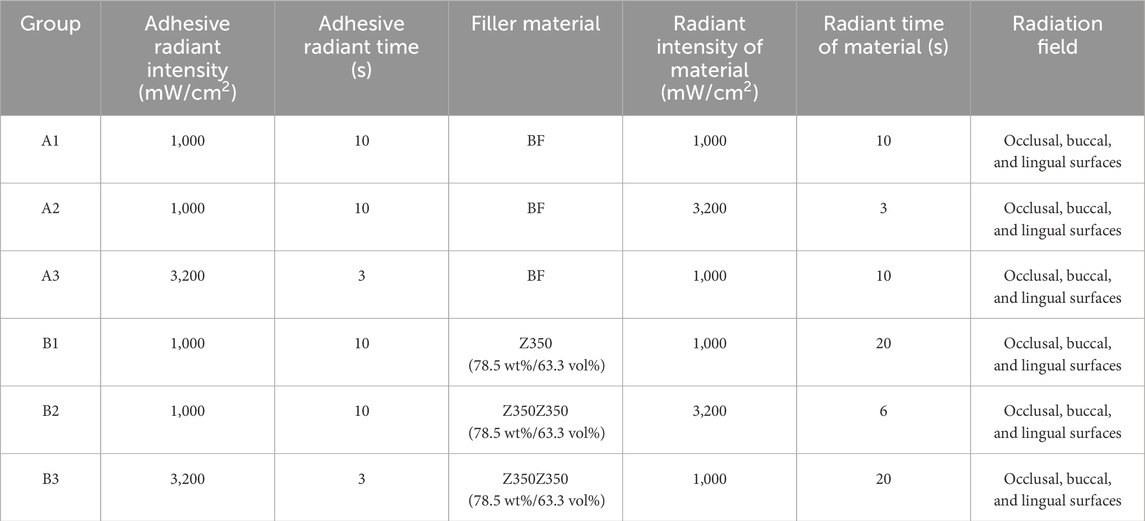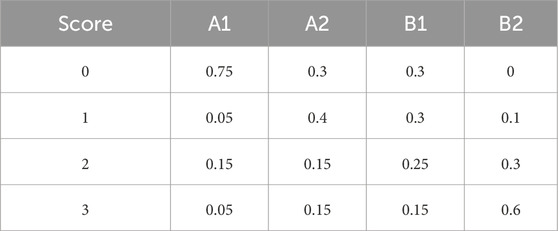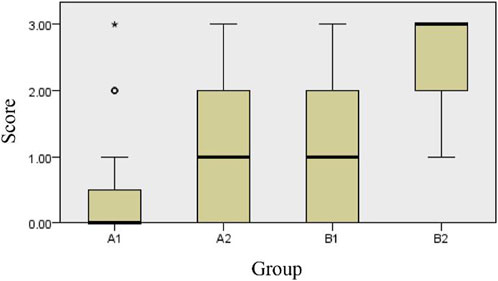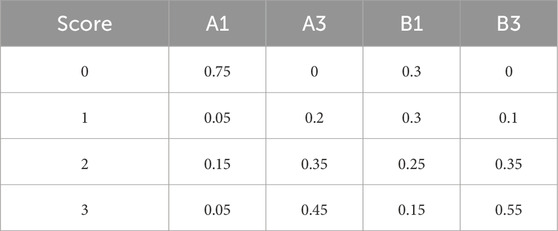- Department of Stomatology, The Second Affiliated Hospital of Jiaxing University, Jiaxing, Zhejiang, China
Purpose: This study compared the effect of high-intensity (3,200 mW/cm2) and conventional-intensity (1,000 mW/cm2) light curing on the micro-leakage properties of conventional and bulk-fill resin composites.
Methods: Cavities were respectively prepared on the mesial and distal surfaces of 60 molars. 3M™ Filtek™ One Bulk Fill Restorative (BF), 3M™ Filtek™ Z350 XT Universal Restorative (Z350), and 3M™ Single bond universal adhesive were used to fill the molars with different light-curing modes. After temperature cycling, staining, and sectioning, the micro-leakage of these teeth was observed with a microscope.
Results: In the condition of adhesive at standard power, the micro-leakage of BF in both light-curing irradiation modes showed no significant differences (P > 0.05), and that of Z350 was significantly increased following high-intensity irradiation (P < 0.05). Compared with the standard mode, the micro-leakage was significantly higher (P < 0.05) for both BF and Z350 under the condition of high-intensity irradiation for adhesive.
Conclusion: A high-power and short-duration light mode is not suitable for all materials. The selection of the light-curing mode should be based on the material composition and physicochemical properties, determining the appropriate irradiation time and intensity to minimize micro-leakage in resin-based restorative materials and thereby ensure a favorable restoration prognosis.
Introduction
Composite resin, as a filling material in dentistry, has been widely used in the filling treatment of dental caries for the advantages of its good biocompatibility, superior aesthetic characteristics, and good physical and mechanical properties (Yadav and Kumar, 2019). With the advancement of research on resin composite materials, adhesive systems, and light-curing units, resin-based restorations have become increasingly time-efficient and convenient (Jacob and Goud, 2023). However, inherent polymerization shrinkage (2%–5% volumetric contraction from covalent bond formation) remains a critical challenge (Mosharrafian et al., 2023). The main factors affecting polymerization shrinkage include the geometric shape of the cavity, the method of resin filling, the form of light curing, the physical properties of the resin used, and so on. To mitigate the effects of polymerization shrinkage and ensure sufficient light penetration, the incremental (layered) filling technique limits each layer to a maximum of 2 mm in thickness. Despite its advantages, this method is time-consuming and susceptible to contamination or bonding failure between layers, where the thickness of each layer is limited to a maximum of 2 mm. Layered filling technology has drawbacks such as long-time consumption, contamination of gaps between different material layers, risk of interlayer bonding failure, and difficulty in placing materials with small and deep cavities (Hirata et al., 2023). Bulk-fill resin composites represent a class of polymer-based restorative systems specifically engineered for posterior applications, characterized by their capacity for single-increment placement at incremental thicknesses up to 4 mm while maintaining optimal depth of cure. These materials demonstrate reduced polymerization contraction stress profiles and enhanced rheological characteristics compared to conventional incremental-fill composites, thereby facilitating improved adaptation and clinical performance. The bulk-fill resin composite system has been shown to significantly reduce clinical procedure time while mitigating interfacial integrity compromise associated with polymerization stress accumulation in incremental placement techniques, thereby enhancing restoration longevity through optimized monomer conversion kinetics.
During the process of resin restoration, the resin binder system plays an important role in the connection of dentin or enamel surfaces to the resin restorative materials. An ideal resin-bonded interface will ensure adequate bond strength, marginal tightness, and durability (Dressano et al., 2020). Studies have shown that the final properties and bond stability of resin binders are closely related to the polymerization conversion rate (Breschi et al., 2007).
The light-curing method used in clinical practice directly affects the performance of the restorative resin, including the wavelength, intensity, and duration of the curing time (Besegato et al., 2019). To reduce the polymerization shrinkage stress of composite resin, various irradiation methods, including soft start and pulse delay, have been proposed and have achieved some results (Lopes et al., 2009; Carvalho et al., 2012; Taubock et al., 2014). However, these techniques have not been widely used in clinical practice for their technical sensitivity and long time consumption. According to the Bunsen–Roscoe law of reciprocity in photochemistry, the exposure reciprocity law (ERL) suggests that the final properties of light-cured resins depend on the total energy delivered (J/cm2). The ERL has been proposed for light-curing resin, which means the properties of cured resins depend on the curing irradiation exposure. The unit of exposure, J/cm2, refers to the product of irradiance (incident light intensity, mW/cm2) and irradiation time (Li and Suh, 2007). The adaptability of the ERL has been validated in studies on the double bond conversion rate (DC), flexural strength, elastic modulus, hardness, and other aspects of some dental materials (Li and Suh, 2007). As a result, manufacturers have introduced high-intensity LED curing lights that could significantly shorten the curing time while maintaining the same total exposure.
Clinicians value time-efficient treatment methods, particularly in pediatric care. The use of bulk-fill composite materials combined with high-intensity, short-duration light curing reduces treatment time. This approach minimizes the challenges posed by limited patient cooperation and the risk of salivary contamination during resin-based restorations. However, some studies have also found that although irradiation exposure plays an important role, irradiation and time independently affect polymer chain length, crosslinking degree, and mechanical properties (Gul et al., 2020), so the ERL is not applicable under all conditions. This study investigates the micro-leakage risks associated with high-intensity curing in both conventional and bulk-fill composites, particularly when combined with eighth-generation self-etch adhesives. The findings aim to clarify the applicability of rapid-curing protocols and guide the clinical optimization of light-curing strategies.
Materials and methods
Experimental subjects
A total of 60 clinically extracted human molars were selected based on the inclusion criteria of having intact crowns, no caries, no developmental defects, no restorations, and no cracks. All calculus and connective tissue were removed through scaling, and the extracted teeth were stored in 0.9% physiological saline at 4°C for up to 3 months until the commencement of the study. Standardized Black II class cavities were prepared using a #245 carbide bur (Mani, Tochigi, Japan) with the following dimensions: 4 mm occlusal–gingival depth, 4 mm buccal–lingual width, and 2 mm axial depth. Each tooth contained two cavities: a mesial and a distal cavity, with an inter-cavity distance of 6–11 mm. All cavity margins were located within enamel to ensure standardized interfacial conditions. During the filling and irradiation procedures, the cavities were treated independently. A black light-blocking shield (Dentsply Sirona, NC, United States) was applied to prevent scattered light from curing the adjacent untreated cavity, thereby eliminating cross-contamination between experimental groups. The study was approved by the Ethics Committee of The Second Affiliated Hospital of Jiaxing University (No. JXEY-2020JX013). Informed consent was obtained from all participants, and all methods adhered to the Declaration of Helsinki.
Selection of resin
Filtek™ Z350 XT was included as a conventional resin control to compare polymerization behavior against bulk-fill materials. Both materials were chosen for their clinical prevalence and well-documented performance in prior micro-leakage studies. 3M™ Filtek™ One Bulk Fill Restorative (BF), a bulk-fill resin, was used for posterior teeth as the UV-cured composite resin and was obtained from 3M Oral Care (3M), (St. Paul, MN, United States). 3M™ Filtek™ Z350 XT Universal Restorative, selected as the ordinary resin, was obtained from 3M. 3M™ Single Bond Universal Adhesive was selected as the adhesive and was purchased from 3M. The material compositions and manufacturers are shown in Table 1.
Selection of the UV curing lamp
The VALO curing lamp was obtained from Ultradent South Jordan (UT, United States); it uses 3,200 mW/cm2 for Xtra-power mode and 1,000 mW/cm2 for standard mode. The specific related parameters of UV curing lamps are shown in Table 2.
Grouping
Each group is equipped with 20 fillers (Campos et al., 2014; Garcia et al., 2019). Six experimental groups were set up with different irradiation intensities, times, and filling materials. The specific conditions are shown in Table 3.
Preparation of research models
Cavities were prepared following a standardized protocol, with each tooth subjected to occlusal surface preparation, maintaining a gingival distance of 4 mm, a buccal-lingual width of 4 mm, and a gingival wall thickness of 2 mm, with the gingival wall positioned above the enamel–dentin junction (Miletic et al., 2016). The filling technique adhered to the manufacturer’s instructions: bulk-fill composite resin was applied in a single increment, while conventional resins were placed in layers. Thermal cycling was conducted between 5°C and 55°C. Each cycle consisted of 30 s at each temperature, with a 10-s transition time between temperature changes, resulting in a total cycle duration of 70 s, resulting in a cumulative exposure time of approximately 4,000 s (11.11 h). The 5°C–55°C temperature range was selected to mimic the oral environment, considering that oral temperatures typically fluctuate between 5°C and 55°C due to food consumption, despite the average resting temperature being around 37°C. The differing thermal expansion coefficients of oral tissues and composite resins may exacerbate micro-leakage during thermal cycling.
Determination of micro-permeability
The apical foramen and teeth were coated with a sealant prior to staining and stained with 2% methylene blue at 37°C for 4 h (Luo and Chen, 2016). The degree of dye penetration was scored using a stereomicroscope. The scoring criteria are as follows: 0 for colorless, one for staining area less than 1/2 of the gingival wall, two for staining area greater than 1/2 of the gingival wall or all staining, 3 for staining that penetrates the cervix directly to the pulp cavity (Figure 1). This step must be observed by an investigator and subjected to a consistency test (Orabi et al., 2023).
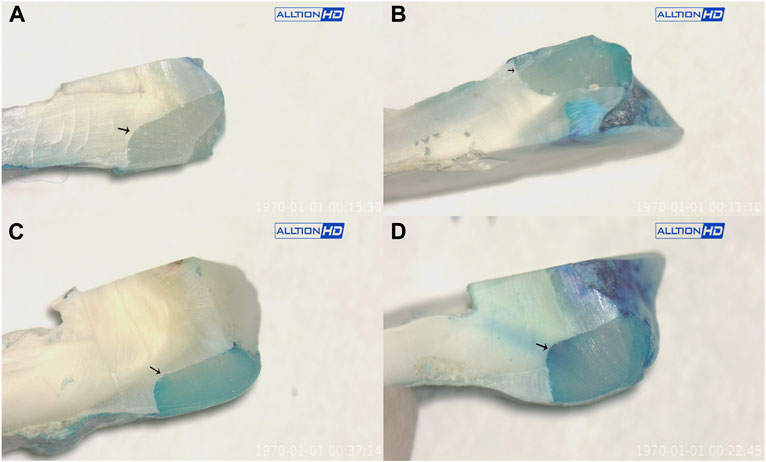
Figure 1. The scoring criteria for the detection of micro-leakage by the dye penetration method. Demonstration of the staining of 0 (A), 1 (B), 2 (C), and 3 points (D).
Statistical analysis
The micro-leakage data for each group were recorded in tables, and the non-parametric Kruskal–Wallis H test was applied to compare the micro-leakage scores across all samples. The null hypothesis (H0) posited that there were no significant differences in micro-leakage between the groups. Data analysis was conducted using SPSS software, and a P-value of <0.05 was considered to indicate statistical significance.
Results
The micro-leakage of BF and Z350 varied under high and low power radiation
The results under the stereomicroscope showed that the binder after routine irradiation and the exposure of each group of resins to different light-curing irradiation intensities resulted in different amounts of micro-leakage (P < 0.001, micro-leakage scoring statistics are shown in Table 4; Figure 2). As shown in Table 5, the micro-leakage of the BF did not differ significantly between the standard power curing at 10 s (Group A1) and the Xtra-power curing at 3 s (Group A2) (P = 0.351), whereas the Z350 resin showed a higher micro-leakage under the Xtra-power curing at 6 s (P = 0.006). Meanwhile, there was no significant difference in micro-leakage between BF irradiated for 10 s and Z350 irradiated for 20 s under conventional power light (P = 0.198).
Adhesives with high-intensity radiation may increase the risk of micro-leakage
The effect of binder on resin micro-leakage is shown in Table 6 and Figure 3. Further analysis, as shown in Table 7, showed a significant difference between groups A1 and A3 and B1 and B3. This result indicated that in the condition of Xtra power 3 s, the probability of adhesive-induced micro-leakage was significantly increased in both BF and Z350 resins (p < 0.001).
Discussion
Micro-leakage is one of the significant factors leading to the failure of resin repair. The polymerization shrinkage of resin repair during the curing process can cause micro-leakage (Par et al., 2020). The timing, intensity, and distribution of resin polymerization shrinkage are related to many factors in addition to the physicochemical properties of the filling resin itself: the size and morphology of the sockets, the adaptation and adhesion of the resin to the sockets, the mode of light curing, and the method of filling also affect the polymerization shrinkage of the resin (Hayashi et al., 2020). A uniform cavity specification was used in this study of the resin filling model: the Black II cavity is commonly used in clinical practice to avoid the influence of different cavity types on the study. The cavity size of a 4 mm gingival distance multiplied by a 4 mm buccal-lingual distance multiplied by a 2 mm gingival wall width was chosen because 2 mm is a node in the filling depth. The maximum filling depth is 2 mm for regular resin and 4 mm for bulk-fill resin (Feng et al., 2009; Al-Harbi et al., 2016). Therefore, under the conditions of using the same resin binder, the variables of the entire experiment were controlled by two aspects: the properties of the resin itself and the condition of light curing.
Manufacturers of bulk-fill resins have met the challenge of reducing polymerization shrinkage stress by varying filler content and shape, changing the molecular weight and structure of the monomers, adding stress relievers and polymerization modifiers, adding polymerization inhibitors, and using new photoinitiators, new combinations of improved material translucency, and dual-cure polymerization mechanisms (Hayashi et al., 2020). Many studies have shown that bulk-filled resin one-shot filling is similar to conventional resin layering techniques in terms of margin-filling quality (Dressano et al., 2020; Campos et al., 2014; Pereira et al., 2019; Haak et al., 2019; Gerula-Szymanska et al., 2020). The results of our study also confirmed this conclusion, with no significant difference in micro-leakage between the two resin layering techniques under conventional light curing (P = 0.198).
In the early stages of resin photopolymerization, the chains formed by the polymer are very flexible and can move freely, which can compensate for some of the shrinkage stress. As curing progresses, the fluidity becomes progressively less and ultimately cannot compensate for the shrinkage stress (Cayo-Rojas et al., 2021). One study found that in the very early stages of resin curing, high-power irradiation could accelerate the generation of free radicals, thereby accelerating polymerization reactions (Ilie et al., 2005). Meanwhile, the increase in temperature caused by high-power irradiation could enhance the viscosity of the materials and reduce the viscoelastic flow (Hayashi et al., 2020). As a result, greater shrinkage stress will be generated during the curing process, leading to further micro-leakage. This is consistent with the results of this study, which showed that the Z350 resin exhibited higher micro-leakage under 6 s of high-power irradiation.
Shrinkage stress relievers, which act similarly to a microscopic spring, attenuating the forces generated during shrinkage, had a lower modulus of elasticity (Ilie et al., 2005). BF produced by 3M has a similar effect, with a resin system containing two novel methacrylate monomers. Methacrylate composites have an inherent tendency to shrink during polymerization, and the combination of the two monomers in BF reduces the polymerization stress. This is because one of the monomers, high molecular weight aromatic urethane dimethacrylate (AUDMA), reduces the number of reactive groups in the resin, which helps to improve the volume shrinkage and stiffness of the resulting polymer, further reducing the generation of polymerization stresses. Another type of methacrylate is a class of compounds known as addition fragment monomers (AFMs), which not only form cross-links between adjacent polymers but also break down into fragments during polymerization. However, these fragments can still react with each other, and in this way, AFMs eliminate polymerization stresses while maintaining the physical properties of the polymer. In addition, the filler of BF contains 100 nm particles of polymerized ytterbium trifluoride (YbF3), as do the other bulk resin-filled materials, which are used to increase the radiation permeability and thus reduce radiation exposure time. Therefore, the results of this study revealed that BF did not show a difference in its micro-leakage under conventional power light curing for 10 s and high power for 3 s.
The main component of a binder is resin, and the termination of resin polymerization is usually a bimolecular process. When the number of free radicals is large, the loss of free radicals is faster (Selig et al., 2015). In Xtra-power mode, more free radicals are immediately activated. Free radicals are more active in low viscosity conditions, which leads to double radical termination in the early stages of the reaction and results in a significant loss of free radicals and a decrease in conversion rate (Jang et al., 2015). In addition, the low-molecular weight monomer HEMA contained in the binder can slow the transition of polymerization reaction from bimolecular termination to monomolecular termination, which also consumes more free radicals and affects the photopolymerization reaction (Dressano et al., 2020; Feng et al., 2009). Some studies have determined the conversion rates of binders and composite resins under different light-curing intensities and found that low-viscosity composite materials (binders) exhibit poorer curing performance under high-power and short-time irradiation than high-viscosity composite resin (Par et al., 2020; D'Alpino et al., 2007). The mechanical properties of light-cured materials are largely dependent on their curing efficiency, so poor curing performance indicates a higher probability of micro-leakage. This is supported by the fact that the binder in this study significantly increased the likelihood of micro-leakage in both BF and Z350 in the high-power 3 s mode.
In conclusion, the two resins, BF and Z350, did not have the same micro-leakage with changes in irradiation intensity and irradiation time. The results of this study confirmed that it is not desirable to complete the light-curing process simply by increasing the irradiation intensity and decreasing the irradiation time. Therefore, in clinical practice, only by following the light-curing protocol recommended by the manufacturers can the mechanical properties of the cured material be maximized and the quality of resin-filled restorations be ensured. However, this study has several limitations. First, the types of resin materials and adhesives used were relatively limited. Given the compositional variability among different commercial products, this may affect the generalizability of the findings. While Fourier-transform infrared (FTIR) spectroscopy could directly quantify the degree of conversion, our study deliberately focused on clinical outcome assessment through micro-leakage evaluation. This methodological decision was based on previously established correlations between curing protocols and bond degradation, supporting the clinical relevance of our approach (Feitosa et al., 2013). Nonetheless, we acknowledge that quantifying the degree of chemical conversion remains essential for a more comprehensive understanding of polymerization dynamics, and we plan to integrate FTIR analysis in future investigations. Furthermore, the extent to which different light-curing protocols affect the degree of conversion requires additional experimental validation. Second, resin fillers are not only affected by temperature stimuli in the patient’s oral cavity but also subjected to repeated effects of various external forces such as shear and compression. The stress environment was not simulated in this study, which is also a limitation. In addition, there are differences in the development of dentin between deciduous teeth and permanent teeth, as well as differences at different age stages of tooth development. The extracted teeth collected in this study were all permanent teeth and were not distinguished by age stage. The issues suggested above will be further investigated and improved in future studies.
Conclusion
The ERL is not suitable for all conditions. The choice of irradiation conditions is closely related to the composition of the light-curing material. In clinical practice, the blind application of high-power, short-duration curing protocols to save time may affect the mechanical properties of the cured material and, thus, the quality of the restoration. Therefore, the instructions for the use of the selected light-curing material should be followed to determine the curing protocol, or a more refined curing time and power should be investigated to achieve optimal restorative results.
Data availability statement
The raw data supporting the conclusions of this article will be made available by the authors, without undue reservation.
Ethics statement
This study was approved by the Ethics Committee of The Second Affiliated Hospital of Jiaxing University (No. JXEY-2020JX013). Informed consent was obtained from all the participants. All methods were carried out in accordance with the Declaration of Helsinki. The studies were conducted in accordance with the local legislation and institutional requirements. The participants provided their written informed consent to participate in this study.
Author contributions
YL: Data curation, Formal analysis, Methodology, Project administration, Resources, Writing – original draft, Writing – review and editing. QC: Data curation, Formal analysis, Methodology, Software, Visualization, Writing – review and editing. DZ: Conceptualization, Funding acquisition, Investigation, Resources, Supervision, Writing – review and editing.
Funding
The author(s) declare that financial support was received for the research and/or publication of this article. This study was supported by the Jiaxing Science and Technology Program Project Effect of high-power mode of light-curing lamp on resin micro-leakage NO. (2020AD30111).
Acknowledgments
The authors thank the participants for all their support and contributions.
Conflict of interest
The authors declare that the research was conducted in the absence of any commercial or financial relationships that could be construed as a potential conflict of interest.
Generative AI statement
The author(s) declare that no Generative AI was used in the creation of this manuscript.
Publisher’s note
All claims expressed in this article are solely those of the authors and do not necessarily represent those of their affiliated organizations, or those of the publisher, the editors and the reviewers. Any product that may be evaluated in this article, or claim that may be made by its manufacturer, is not guaranteed or endorsed by the publisher.
Abbreviations
3M, 3M Oral Care; AFM, dynamic stress-relieving monomer; AUDMA, aromatic urethane dimethacrylate;BF, 3M™ Filtek™ One Bulk Fill Restorative; DC, double bond conversion rate; DMAEMA, 2-(dimethylamino) ethyl methacrylate; EMA, methyl ethylene acrylate; ERL, exposure reciprocity law; GMA, glycidyl methacrylate; HEMA, hydroxyethyl methacrylate; PEGDMA, poly (ethyleneglycol) dimethacrylate; TEGDMA, triethylene glycol dimethacrylate; UDMA, polyurethane dimethacrylate; Z350, 3MTM FiltekTM Z350 XT Universal Restorative.
References
Al-Harbi, F., Kaisarly, D., Bader, D., and Gezawi, M. E. I. (2016). Marginal integrity of bulk versus incremental fill class II composite restorations. Oper. Dent. 41, 146–156. doi:10.2341/14-306-l
Besegato, J. F., Jussiani, E. I., Andrello, A. C., Fernandes, R. V., Salomão, F. M., Vicentin, B. L. S., et al. (2019). Effect of light-curing protocols on the mechanical behavior of bulk-fill resin composites. J. Mech. Behav. Biomed. Mater 90, 381–387. doi:10.1016/j.jmbbm.2018.10.026
Breschi, L., Cadenaro, M., Antoniolli, F., Sauro, S., Biasotto, M., Prati, C., et al. (2007). Polymerization kinetics of dental adhesives cured with LED: correlation between extent of conversion and permeability. Dent. Mater 23, 1066–1072. doi:10.1016/j.dental.2006.06.040
Campos, E. A., Ardu, S., Lefever, D., Jasse, F. F., Bortolotto, T., and Krejci, I. (2014). Marginal adaptation of class II cavities restored with bulk-fill composites. J. Dent. 42, 575–581. doi:10.1016/j.jdent.2014.02.007
Carvalho, A. A., Moreira, F. C., Fonseca, R. B., Soares, C. J., Franco, E. B., Souza, J. B. d., et al. (2012). Effect of light sources and curing mode techniques on sorption, solubility and biaxial flexural strength of a composite resin. J. Appl. Oral Sci. 20, 246–252. doi:10.1590/s1678-77572012000200021
Cayo-Rojas, C. F., Hernandez-Caba, K. K., Aliaga-Marinas, A. S., Ladera-Castañeda, M. I., and Cervantes-Ganoza, L. A. (2021). micro-leakage in class II restorations of two bulk fill resin composites and a conventional nanohybrid resin composite: an in vitro study at 10,000 thermocycles. BMC Oral Health 21, 619. doi:10.1186/s12903-021-01942-0
D'Alpino, P. H., Svizero, N. R., Pereira, J. C., Rueggeberg, F. A., Carvalho, R. M., and Pashley, D. H. (2007). Influence of light-curing sources on polymerization reaction kinetics of a restorative system. Am. J. Dent. 20, 46–52.
Dressano, D., Salvador, M. V., Oliveira, M. T., Marchi, G. M., Fronza, B. M., Hadis, M., et al. (2020). Chemistry of novel and contemporary resin-based dental adhesives. J. Mech. Behav. Biomed. Mater 110, 103875. doi:10.1016/j.jmbbm.2020.103875
Feitosa, V. P., Watson, T. F., Vitti, R. P., Bacchi, A., Correr-Sobrinho, L., Correr, A. B., et al. (2013). Prolonged curing time reduces the effects of simulated pulpal pressure on the bond strength of one-step self-etch adhesives. Oper. Dent. 38 (5), 545–554. doi:10.2341/12-180-L
Feng, L., Carvalho, R., and Suh, B. I. (2009). Insufficient cure under the condition of high irradiance and short irradiation time. Dent. Mater 25 (3), 283–289. doi:10.1016/j.dental.2008.07.007
Garcia, M. L., Climent, G. A., and L Lena, P. C. (2019). In vitro evaluation of micro-leakage in Class II composite restorations: high-viscosity bulk-fill vs conventional composites. Dent. Mater J. 38, 721–727. doi:10.4012/dmj.2018-160
Gerula-Szymanska, A., Kaczor, K., Lewusz-Butkiewicz, K., and Nowicka, A. (2020). Marginal integrity of flowable and packable bulk fill materials used for class II restorations -A systematic review and meta-analysis of in vitro studies. Dent. Mater J. 39, 335–344. doi:10.4012/dmj.2018-180
Gul, P., Alp, H. H., and Ozcan, M. (2020). Monomer release from bulk-fill composite resins in different curing protocols. J. Oral Sci. 62, 288–292. doi:10.2334/josnusd.19-0221
Haak, R., Nake, T., Park, K. J., Ziebolz, D., Krause, F., and Schneider, H. (2019). Internal and marginal adaptation of high-viscosity bulk-fill composites in class II cavities placed with different adhesive strategies. Odontology 107, 374–382. doi:10.1007/s10266-018-0402-1
Hayashi, J., Tagami, J., Chan, D., and Sadr, A. (2020). New bulk-fill composite system with high irradiance light polymerization: integrity and degree of conversion. Dent. Mater 36, 1615–1623. doi:10.1016/j.dental.2020.10.012
Hirata, R., Sampaio, C. S., Atria, P. J., Giannini, M., Coelho, P. G., and Yamaguchi, S. (2023). Effect of high-radiant emittance and short curing time on polymerization shrinkage vectors of bulk fill composites. Oper. Dent. 48, 51–58. doi:10.2341/20-167-l
Ilie, N., Felten, K., Trixner, K., and Kunzelmann, K. H. (2005). Shrinkage behavior of a resin-based composite irradiated with modern curing units. Dent. Mater 21, 483–489. doi:10.1016/j.dental.2004.08.007
Jacob, G., and Goud, K. M. (2023). A comparative study on micro-leakage of two low shrinkage composite materials in Class II cavities: a stereomicroscopic analysis. J. Conserv. Dent. 26, 83–87. doi:10.4103/jcd.jcd_444_22
Jang, J. H., Park, S. H., and Hwang, I. N. (2015). Polymerization shrinkage and depth of cure of bulk-fill resin composites and highly filled flowable resin. Oper. Dent. 40, 172–180. doi:10.2341/13-307-l
Li, F., and Suh, B. I. (2007). Exposure reciprocity law in photopolymerization of multi-functional acrylates and methacrylates. Macromol. Chem. Phys. 208, 295–306. doi:10.1002/macp.200600480
Lopes, L. G., Jardim, F. A. V., de Souza, J. B., Rabelo, D., Franco, E. B., and de Freitas, G. C. (2009). Influence of pulse-delay curing on sorption and solubility of a composite resin. J. Appl. Oral Sci. 17, 27–31. doi:10.1590/s1678-77572009000100006
Luo, R., and Chen, Y. M. (2016). The effect of super power mode of bait laser preparation and photocuring lamp on resin micro-leakage. Stomatology 36, 403–406.
Miletic, V., Peric, D., Milosevic, M., Manojlovic, D., and Mitrovic, N. (2016). Local deformation fields and marginal integrity of sculptable bulk-fill, low-shrinkage and conventional composites. Dent. Mater 32, 1441–1451. doi:10.1016/j.dental.2016.09.011
Mosharrafian, S., Farahmand, N., Poorzandpoush, K., Hosseinipour, Z. S., and Kahforushan, M. (2023). In vitro micro-leakage at the enamel and dentin margins of class II cavities of primary molars restored with a bulk-fill and a conventional composite. Clin. Exp. Dent. Res. 9, 512–517. doi:10.1002/cre2.729
Orabi, K. B. M., Bshara, N., and Alzoubi, H. (2023). Evaluation of self-adhesive composite restorations bond on primary canines: an in vitro study. Cureus 15, e35005. doi:10.7759/cureus.35005
Par, M., Marovic, D., Attin, T., Tarle, Z., and Tauböck, T. T. (2020). Effect of rapid high-intensity light-curing on polymerization shrinkage properties of conventional and bulk-fill composites. J. Dent. 101, 103448. doi:10.1016/j.jdent.2020.103448
Pereira, R., Lima, D., Giorgi, M., Marchi, G., and Aguiar, F. (2019). Evaluation of bond strength, nanoleakage, and marginal adaptation of bulk-fill composites submitted to thermomechanical aging. J. Adhes. Dent. 21, 255–264. doi:10.3290/j.jad.a42547
Selig, D., Haenel, T., Hausnerova, B., Hausnerová, B., Moeginger, B., Labrie, D., et al. (2015). Examining exposure reciprocity in a resin based composite using high irradiance levels and real-time degree of conversion values. Dent. Mater 31, 583–593. doi:10.1016/j.dental.2015.02.010
Taubock, T. T., Feilzer, A. J., Buchalla, W., Kleverlaan, C. J., Krejci, I., and Attin, T. (2014). Effect of modulated photo-activation on polymerization shrinkage behavior of dental restorative resin composites. Eur. J. Oral Sci. 122, 293–302. doi:10.1111/eos.12139
Keywords: bulk-fill composite, radiant intensity, light-curing time, dental adhesives, micro-leakage
Citation: Lu Y, Cai Q and Zhou D (2025) Effect of rapid high-intensity light curing on micro-leakage in conventional and bulk-fill resin composites. Front. Mater. 12:1578638. doi: 10.3389/fmats.2025.1578638
Received: 18 February 2025; Accepted: 15 May 2025;
Published: 12 June 2025.
Edited by:
Chung Hae Park, IMT Lille Douai, FranceReviewed by:
Carlos José Espinoza-González, CONACYT Center for Research in Applied Chemistry (CIQA), MexicoSarah Gayot, Arkema, France
Copyright © 2025 Lu, Cai and Zhou. This is an open-access article distributed under the terms of the Creative Commons Attribution License (CC BY). The use, distribution or reproduction in other forums is permitted, provided the original author(s) and the copyright owner(s) are credited and that the original publication in this journal is cited, in accordance with accepted academic practice. No use, distribution or reproduction is permitted which does not comply with these terms.
*Correspondence: Dongyan Zhou, cXdmMjAxNDExMTZAMTYzLmNvbQ==
 Yaojia Lu
Yaojia Lu Dongyan Zhou
Dongyan Zhou

